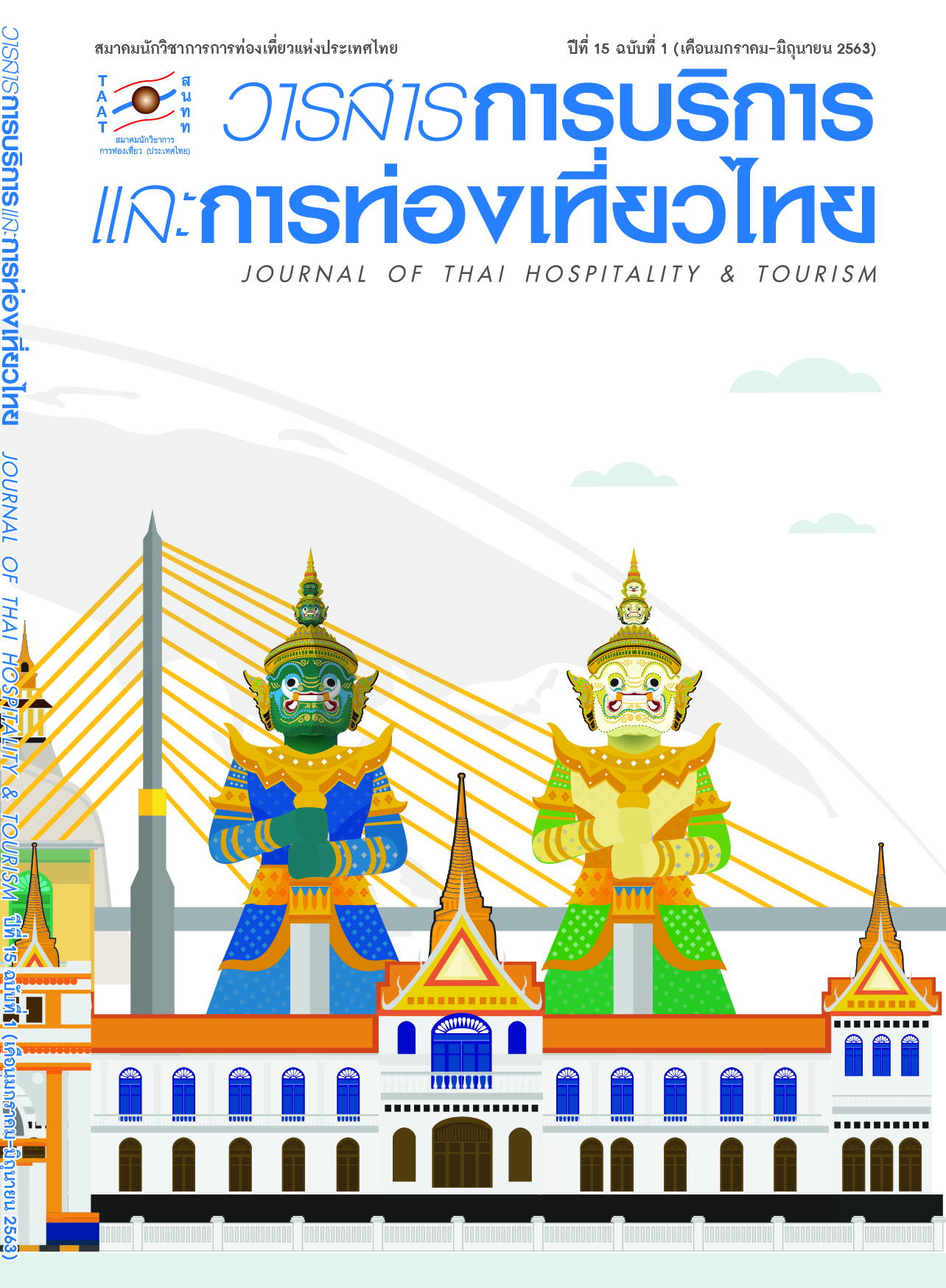กลยุทธ์การประกอบธุรกิจของธุรกิจสายการบินต้นทุนต่ำในประเทศไทย
Main Article Content
บทคัดย่อ
บทความนี้มีวัตถุประสงค์เพื่อนำเสนอแนวคิดกลยุทธ์การประกอบธุรกิจของธุรกิจสายการบินต้นทุนต่ำในประเทศไทย ซึ่งใช้วิธีการวางตำแหน่งสินค้าของบริษัทเพื่อให้ตรงกับความต้องการของกลุ่มลูกค้าเป้าหมาย โดยมีเป้าหมายเพื่อให้สามารถตอบโจทย์ความต้องการของลูกค้าให้ได้ดี มุ่งเน้นที่ความสามารถในการทำกำไรได้เหนือกว่าคู่แข่งขันที่อยู่ในตลาดทั่วไป (Mass Marketing) การมุ่งให้ความสำคัญกับลูกค้าจะทำให้องค์กรจับทางลูกค้าได้ดี ก่อให้เกิดความได้เปรียบในการแข่งขันได้ในท้ายที่สุด ธุรกิจสายการบินต้นทุนต่ำในประเทศไทยมีการเติบโตขึ้นอย่างต่อเนื่องมาโดยตลอด ความสามารถในการทำกำไรในธุรกิจสายการบินต้นทุนต่ำอย่างยั่งยืน ผู้ประกอบธุรกิจจะต้องกำหนดแนวทางการทำงานที่ชัดเจนรวมทั้งการมีกลยุทธ์ในการทำงานที่เหมาะสมกับบริบทและสภาพแวดล้อมให้ทันกับสภาวะปัจจุบันอยู่เสมอ รวมถึงความสามารถในการสร้างความได้เปรียบในการแข่งขันซึ่งจะนำพาให้การประกอบธุรกิจประสบความสำเร็จได้ตามเป้าหมายที่วางไว้
ผลการศึกษา พบว่าธุรกิจสายการบินต้นทุนต่ำในประเทศไทย อาทิ สายการบินไทยสมายล์แอร์เวย์ (Thai Smile Airways) สายการบินไทยแอร์เอเชีย (Thai AirAsia) และสายการบินไทยไลอ้อนแอร์ (Thai Lion Air) ใช้กลยุทธ์แบบผสมผสานในการประกอบธุรกิจทั้งเรื่องกลยุทธ์ด้านการเป็นผู้นำด้านต้นทุน (Cost-Leadership Strategy) กลยุทธ์การสร้างความแตกต่างในสินค้าและบริการ (Differentiation Strategy) และกลยุทธ์การมุ่งจุดสนใจเฉพาะกลุ่ม (Focus Strategy) ซึ่งช่วยให้องค์กรสามารถออกแบบสินค้าและบริการเพื่อตอบสนองความต้องการของลูกค้าได้ตรงกับใจลูกค้า ทั้งยังจะช่วยให้องค์กรพัฒนาและเติบโตอย่างต่อเนื่องและสามารถบรรลุเป้าหมายในการสร้างกำไรอย่างยั่งยืน
Article Details

อนุญาตภายใต้เงื่อนไข Creative Commons Attribution-NonCommercial-NoDerivatives 4.0 International License.
เอกสารอ้างอิง
Agarwal, R. & Prasad, J. (1998). A Conceptual and Operational Definition of Personal Innovativeness in the Domain of Information Technology. Information Systems Research, 9(2), 204–215.
Attapol Moungsawad & Dusit Sirisombat. (2018). The Service Operations Guidelines for Ultra Low–cost Carriers in Thailand. Journal of Thai Hospitality and Tourism, 14(2), 52–63.
Barnet, R. (2014). Strategic Management: Formulation and Implementation. Retrieved from https://www.strategy–formulation.24xls.com/en509
Barrett, S. D. (2004). How do the Demands for Airport Service Differ between Full–Service Carriers and Low–Cost Carriers?. Journal of Air Transport Management, 10(1), 33–39.
Barsky, J. D. & Labagh, R. (1992). A Strategy for Customer Satisfaction. Cornell Hotel and Restaurant Administration Quarterly, 33(5), 32–40.
Brand Buffet. (2015). AirAsia is not afraid of Presenter Bruised “Nadech” Contract with 3 Years to break the Point of Sale on Time. Retrieved from https://www.brandbuffet.in.th/2015/09/thai-air-asia-nadech-presenter-3rd
Doganis, R. (2001). The Airline Business in the 21st Century. London: Routledge.
Ekkarat Suwannakul & Rugphong Vongsaroj. (2018). The Adaptation of Low–Cost Airline Business Model in Thailand: The Consequences of Competitive Pressures and Challenges. Journal of Thai Hospitality & Tourism, 14(2), 102–115.
Evans, N. (2015). Strategic Management for Tourism, Hospitality and Events. 2nd ed. Routledge.
Farzana, G. R. J. & Ilayaraja, D. (2015). Decision Making of Consumers in the Consumption of Wedding Services with Special Reference to Femina Hotel. International Journal of Management, 6(1), 46–58.
Formisana, R. A. (2004). Manager’s Guide to Strategy. New York: McGraw–Hill, pp.113–122.
Francis, G., Humpreys, I., Ison, S. & Aicken, M. (2006). Where Next for Low Cost Airlines?: A Spatial and Temporal Comparative Study. Journal of Transport Geography, 14(2), 83–94.
Jira Buatong. (2004). Low Cost Airlines and their Impact on Tourism. Retrieved from https://etatjournal.com/upload/11/LowCost.pdf
Kandampully, J. & Suhartanto, D. (2000). Customer Loyalty in the Hotel Industry: the Role of Customer Satisfaction and Image. International Journal of Contemporary Hospitality Management, 12(6), 346–351.
Kornnatapornkrongpop Stantripop, Thanakorn Sirisugandha & Suthinan Promsuwan. (2017). The Relationships Among Service Quality Perceived Value Image Airline and Customer Satisfaction Affecting Buying Intention of Low-Cost Airlines Service in Thailand. Journal of Yala Rajabhat University, 12(2), 139–152.
Malighetti, P., Palaeri, S. & Redondi, R. (2009). Pricing Strategies of Low-Cost Airlines: The Ryanair Case Study. Journal of Air Transport Management, 15, 195–203.
O’Connell, J. F. & Williams, G. (2005). Passengers’ Perceptions of Low Cost Airlines and Full Service Carriers: A Case Study involving Ryanair, Aer Lingus, Air Asia and Malaysia Airlines. Journal of Air Transport Management, 11(4), 259–272.
Ovidiu, N. B., Anca, I. B., Razvan, L. N. & Catalina, S. M. (2010). The Use of Michael Poter’s Generic Strategies in the Romanian Hotel Industry. International Journal of Trade, Economics and Finance, 1(2), 173–178.
Pichpiya Pengpong. (2015). Technology Acceptance, Trust, Price–saving Orientation, and Innovativeness Affecting the Intention to Purchase Low-cost Airlines’ Online Flight Tickets of Customers in Bangkok. Master’s Thesis. Faculty of Business Administration, Bangkok University.
Porter, M. E. (1980). Competitive Strategy: Techniques for Analyzing Industries and Competitors. New York: Free Press, pp.127–133.
Rust, R. T., Lemon, K. N. & Zeithaml, U. A. (2004). Return on Marketing: Using Customer Equity to Focus Market Strategy. Journal of Marketing, 68(1), 109–127.
Sirithon Korbangyang & Phapruke Ussahawanitchakit. (2010). Organizational Adaptability Competency and Its Antecedents and Consequences: An Empirical Investigation of Hotel Businesses in Thailand. Journal of International Business and Economics, 10(2), 20–31.
Sompong Amnuay–ngerntra. (2016). Value Added Creation in Hotel Business with Blue Ocean Strategy. Silpakorn University Journal, 36(1), 1–23.
Suchonnee Metiyothin. (2012). Competitive Strategies. Executive Journal, 32(3), 127–133.
Sumana Nilramphai. (2007). Affecting Low-cost Airline Usage. Master’s Thesis. Faculty of Economics, Thammasat University.
Suparat Chaisavetkanon & Paweena Khampukka. (2016). Risk Perception of Low–Cost Airline Service. FEU Academic Review, 10(3), 128–142.
Thai Lion Air. (2018). Our Destinations. Retrieved from https://www.lionairthai.com/th/cheap–flights
Thai Smile Airways. (2015). Smile News. Retrieved from https://www.thaismileair.com/th/newsupdates/news_166
Thompson, A. A. (1940). Strategic Management: Concepts and Cases. 12th ed. McGraw–Hill Higher Education, Strickland.
Tolkach, D. & Tse, T. S. M. (2016). Reflections on the Asian Hotel Attributes: the Russian Gaze. Journal of China Tourism Research, 12(3-4), 331–354.
Tourism Authority of Thailand. (2012). Situations and Market Trends for Honeymoon and Wedding Travel. Retrieved from https://etatjournal.com/mobile/index.php/menu–read–tat/menu–2012/menu–2012–jul–sep/35–32555–honeymoon
Waraporn Urkarn & Irsara Udompresert. (2010). The Study of Marketing Factors Affecting the Repurchasing of Low–cost Airline Customers. Kasetsart University.
Warawan Chuwiruch, Prathanporn Jhundra–Intra & Sutana Boonlue. (2016). Service Excellence Strategy and Firm Performance: A Study on Hotel Businesses in Thailand. BU Academic Review, 15(2), 144–160.
Whiteley, R. C. (1991). Why Customer Focus Strategies Often Fail. Journal of Business Strategy, 12(5), 34–37.
Williams, G. (2001). Will Europe’s Charter Carriers be replaced By “No Frills” Scheduled Airlines?. Journal of Transport Management, 7(5), 277–286.


